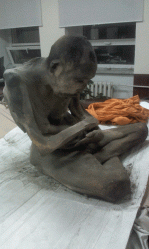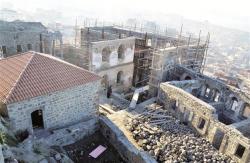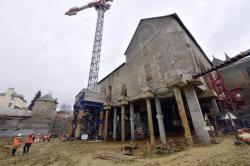INSTITUT SUPERIEUR D'ANTHROPOLOGIE
INSTITUTE OF ANTHROPOLOGY
ONLINE COURSES / COURS A DISTANCE
SPRING TERM : APRIL 2015
REGISTER NOW
MONGOLIE –  Songinokhairkhan - The amazingly intact remains of a meditating monk have been discovered in the Songinokhairkhan province of Mongolia, according to a report in Mongolia’s Morning News. The mummified body, which was covered in animal skin, has been sitting in the lotus position for about 200 years. According to the report, no information is so far available as to where the body was found. “The only details we learned was that it was covered with a cattle skin,” the newspaper wrote. Researchers at the Ulaanbaatar National Centre of Forensic Expertise are now analyzing the remains. According to The Siberian Times, experts are speculating over whether the mummy is a “teacher of famous Lama Dashi-Dorzho Itigilov,” a Buddhist Lama of the Tibetan Buddhist tradition who was born in 1852.Itigilov also died while meditating in lotus posture and was buried in 1927 in that position, his remains laid to rest in a pine box. When he was exhumed in 1955 and in 1973, astonished monks found the body in near-perfect condition and still sitting upright.
Songinokhairkhan - The amazingly intact remains of a meditating monk have been discovered in the Songinokhairkhan province of Mongolia, according to a report in Mongolia’s Morning News. The mummified body, which was covered in animal skin, has been sitting in the lotus position for about 200 years. According to the report, no information is so far available as to where the body was found. “The only details we learned was that it was covered with a cattle skin,” the newspaper wrote. Researchers at the Ulaanbaatar National Centre of Forensic Expertise are now analyzing the remains. According to The Siberian Times, experts are speculating over whether the mummy is a “teacher of famous Lama Dashi-Dorzho Itigilov,” a Buddhist Lama of the Tibetan Buddhist tradition who was born in 1852.Itigilov also died while meditating in lotus posture and was buried in 1927 in that position, his remains laid to rest in a pine box. When he was exhumed in 1955 and in 1973, astonished monks found the body in near-perfect condition and still sitting upright.
http://news.discovery.com/history/archaeology/corpse-of-200-year-old-monk-found-in-lotus-position-150129.htm
TURQUIE –  Kızlar - The restoration of the Kızlar Monastery, one of the most important tourist spots in the Eastern Black Sea region, will soon come to an end and local officials are confident the site will boost local tourism. The monastery complex built on two terraces and is surrounded by a high protective wall. The monastery was founded in the reign of Alexios III (1349–1390). The monastery initially comprised the rock church on the south side the chapel in its entrance and a few cells. Inside the rock church there are inscriptions and portraits of Alexios III, his wife Theodora and his mother Irene.
Kızlar - The restoration of the Kızlar Monastery, one of the most important tourist spots in the Eastern Black Sea region, will soon come to an end and local officials are confident the site will boost local tourism. The monastery complex built on two terraces and is surrounded by a high protective wall. The monastery was founded in the reign of Alexios III (1349–1390). The monastery initially comprised the rock church on the south side the chapel in its entrance and a few cells. Inside the rock church there are inscriptions and portraits of Alexios III, his wife Theodora and his mother Irene.
http://www.hurriyetdailynews.com/monastery-restoration-nears-end-.aspx?pageID=238&nID=77617&NewsCatID=375
INDE –  Hyderabad - A cannon dating to the 17th century and believed to have been used by the forces of Mughal emperor Aurangzeb during the attack on Golconda Fort here has been recovered here, police said. The six-feet-long cannon was found by a person during digging work at Nayapul near Musi River in the old city of Hyderabad. B. Srinivas, director, archaeology and museums, said the cannon of bronze had extraordinary workmanship containing beautiful floral designs and other ornamentation. Aurangzeb, who had camped at Fateh Maidan here in 1687, captured Golconda by defeating the Qutub Shahi ruler Abul Hasan Tanisha. These cannons were used by the rulers of Asaf Jahi dynasty in this region up to the 20th century. According to the official, such cannons were first used by armies of the Delhi Sultanates in early 14th century to attack the Kakatiyas of Warangal Fort in Telangana area.
Hyderabad - A cannon dating to the 17th century and believed to have been used by the forces of Mughal emperor Aurangzeb during the attack on Golconda Fort here has been recovered here, police said. The six-feet-long cannon was found by a person during digging work at Nayapul near Musi River in the old city of Hyderabad. B. Srinivas, director, archaeology and museums, said the cannon of bronze had extraordinary workmanship containing beautiful floral designs and other ornamentation. Aurangzeb, who had camped at Fateh Maidan here in 1687, captured Golconda by defeating the Qutub Shahi ruler Abul Hasan Tanisha. These cannons were used by the rulers of Asaf Jahi dynasty in this region up to the 20th century. According to the official, such cannons were first used by armies of the Delhi Sultanates in early 14th century to attack the Kakatiyas of Warangal Fort in Telangana area.
http://www.business-standard.com/article/news-ians/17th-century-cannon-found-in-hyderabad-115012901594_1.html
SOUDAN –  Tombos - A Purdue University archaeologist is excavating in Tombos, Sudan, to answer questions about the Egyptian and Nubian cultures from thousands of years ago.Michele Buzon, an associate professor of anthropology, is excavating Nubian burial sites dated 1500-1050 BCE in the Nile River Valley to better understand the relationship between the Nubians and Egypt's New Kingdom Empire. She is focusing on a time, starting about 1500 BCE, when Egyptians colonized the area to gain access to trade routes on the Nile River. "What is known about this time often comes from Egyptian history, and we think they integrated more than Egyptian texts convey," said Buzon, a bioarchaeologist. "By excavating the burial tombs we'll investigate if there was intermarriage and how they interacted in general as well as if Egyptians absorbed Nubian culture. Artifacts, burial structure and even burial positions will provide some clues." Buzon is excavating at Tombos, in the Nubian Desert in the far north of Sudan, through late February, and she will be excavating Tombos pyramids, which have remnants of the superstructure with shafts underneath. She is collaborating with Stuart Tyson Smith, professor of anthropology at the University of California-Santa Barbara. This is her fifth excavation in the region.
Tombos - A Purdue University archaeologist is excavating in Tombos, Sudan, to answer questions about the Egyptian and Nubian cultures from thousands of years ago.Michele Buzon, an associate professor of anthropology, is excavating Nubian burial sites dated 1500-1050 BCE in the Nile River Valley to better understand the relationship between the Nubians and Egypt's New Kingdom Empire. She is focusing on a time, starting about 1500 BCE, when Egyptians colonized the area to gain access to trade routes on the Nile River. "What is known about this time often comes from Egyptian history, and we think they integrated more than Egyptian texts convey," said Buzon, a bioarchaeologist. "By excavating the burial tombs we'll investigate if there was intermarriage and how they interacted in general as well as if Egyptians absorbed Nubian culture. Artifacts, burial structure and even burial positions will provide some clues." Buzon is excavating at Tombos, in the Nubian Desert in the far north of Sudan, through late February, and she will be excavating Tombos pyramids, which have remnants of the superstructure with shafts underneath. She is collaborating with Stuart Tyson Smith, professor of anthropology at the University of California-Santa Barbara. This is her fifth excavation in the region.
http://phys.org/news/2015-01-archaeologist-sudan-nile-river-valley.html
FRANCE –  Rennes - Plus de dix mètres de vide séparent le sol du XIVe siècle de l'ancien couvent des Jacobins au c?ur de Rennes, perché sur des dizaines de pieux et de poutres, de ce qui sera le plancher du futur centre des congrès de la ville. Un chantier spectaculaire où le neuf, au lieu de contourner ou de déplacer l'ancien, entend s?y insérer sans le dénaturer. En un an seulement, après avoir patiemment coulé d'immenses poutres transversales en béton sous le vieil édifice, renforcé toutes les ouvertures et voûtes de ce bâtiment inauguré en 1369, percé le sol de dizaines de pieux métalliques, les pelleteuses viennent d'excaver avec d'infinies précautions la terre qui se trouvait en dessous. Désormais perché sur des dizaines de colonnes métalliques de quelque 14 mètres de haut dont l'épaisseur semble bien mince rapportée à l'ampleur de leur charge, le couvent attend, en suspension, la bascule du chantier dans sa deuxième phase: la construction, à ses pieds et dans son sous-sol, du centre des congrès. Sous le niveau de l'ancien édifice religieux, nationalisé à la Révolution, seront construits un parking, un auditorium de 1.000 places, mais aussi une salle de congrès de 500 places.
Rennes - Plus de dix mètres de vide séparent le sol du XIVe siècle de l'ancien couvent des Jacobins au c?ur de Rennes, perché sur des dizaines de pieux et de poutres, de ce qui sera le plancher du futur centre des congrès de la ville. Un chantier spectaculaire où le neuf, au lieu de contourner ou de déplacer l'ancien, entend s?y insérer sans le dénaturer. En un an seulement, après avoir patiemment coulé d'immenses poutres transversales en béton sous le vieil édifice, renforcé toutes les ouvertures et voûtes de ce bâtiment inauguré en 1369, percé le sol de dizaines de pieux métalliques, les pelleteuses viennent d'excaver avec d'infinies précautions la terre qui se trouvait en dessous. Désormais perché sur des dizaines de colonnes métalliques de quelque 14 mètres de haut dont l'épaisseur semble bien mince rapportée à l'ampleur de leur charge, le couvent attend, en suspension, la bascule du chantier dans sa deuxième phase: la construction, à ses pieds et dans son sous-sol, du centre des congrès. Sous le niveau de l'ancien édifice religieux, nationalisé à la Révolution, seront construits un parking, un auditorium de 1.000 places, mais aussi une salle de congrès de 500 places.
https://fr.news.yahoo.com/rennes-couvent-xive-si%C3%A8cle-perch%C3%A9-%C3%A0-10-m%C3%A8tres-180846756.html